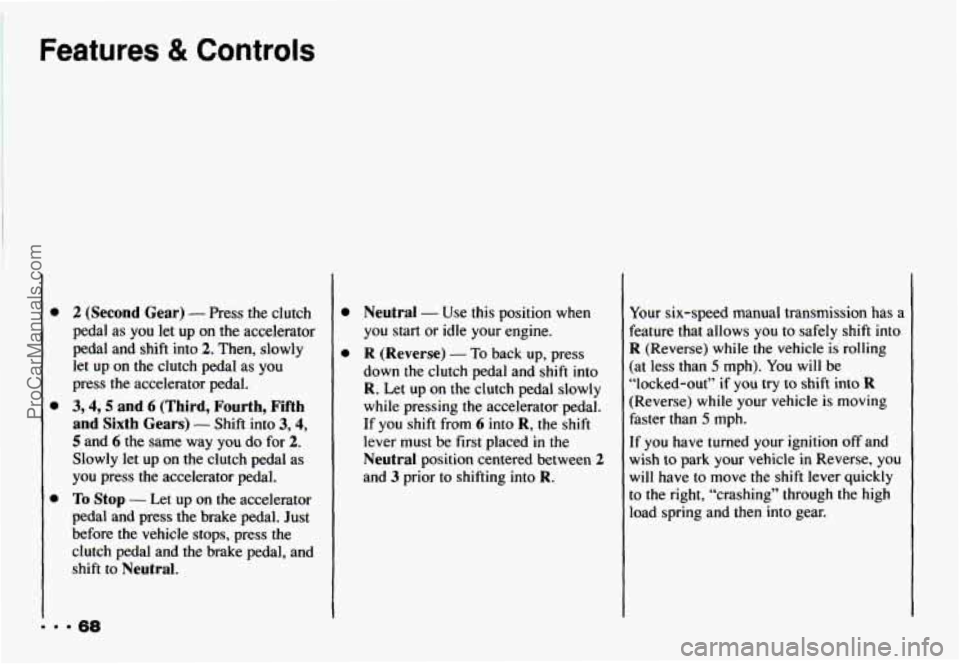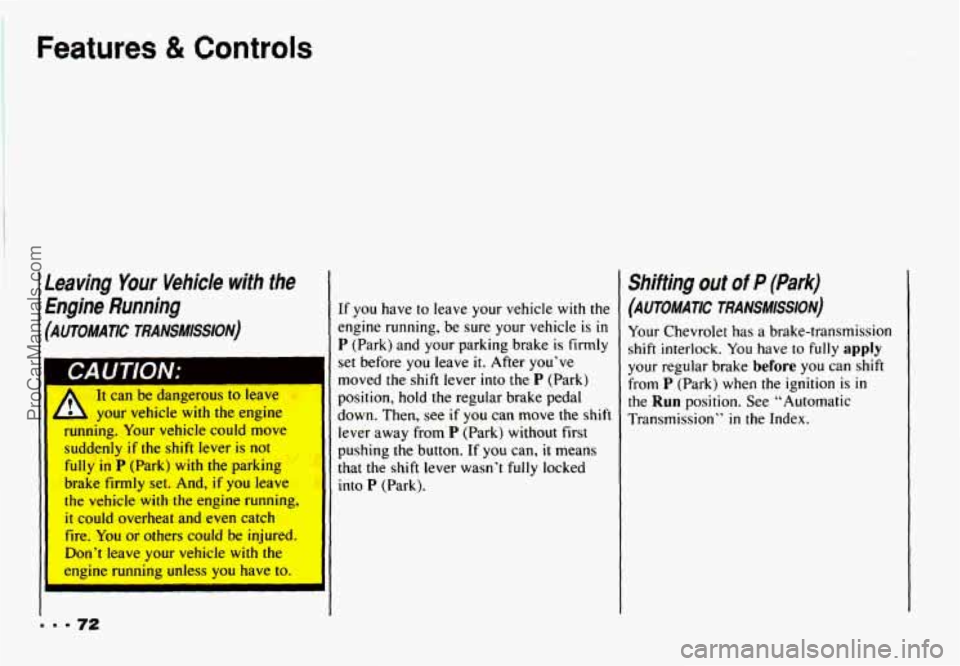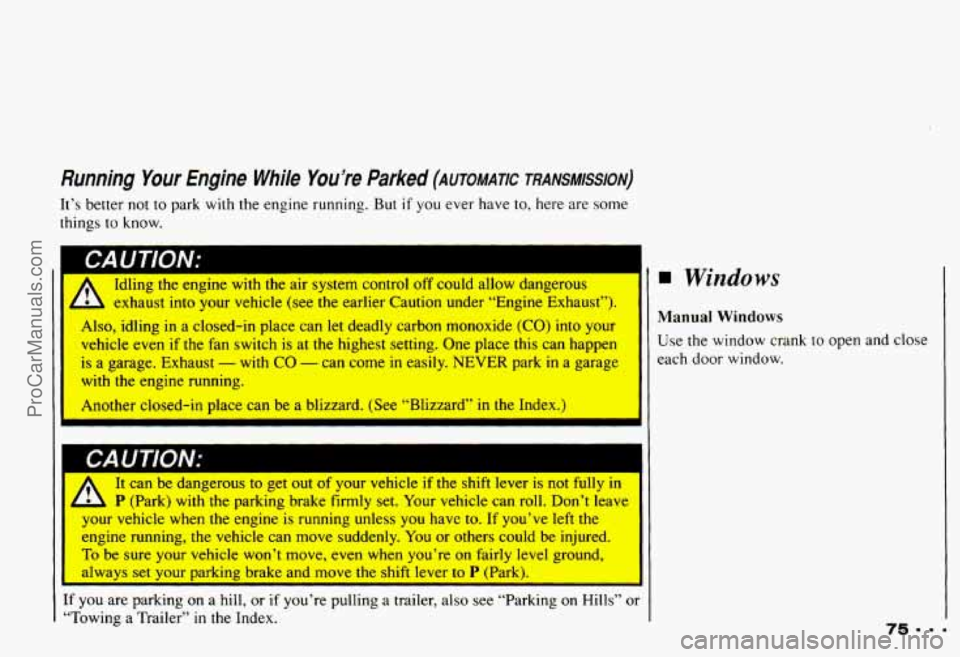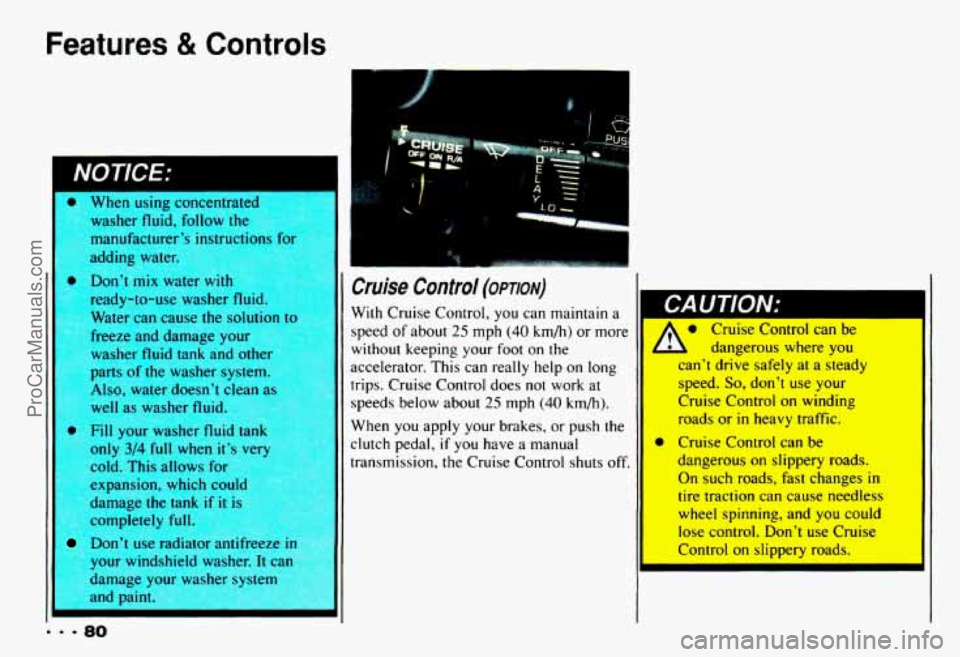Page 72 of 358

Features & Controls
0
0
0
2 (Second Gear) - Press the clutch
pedal as you let up on the accelerator
pedal and shift into
2. Then, slowly
let up on the clutch pedal as you
press the accelerator pedal.
3,4,S and 6 (Third, Fourth, Fifth
and Sixth Gears)
- Shift into 3,4,
5 and 6 the same way you do for 2.
Slowly let up on the clutch pedal as
you press the accelerator pedal.
To Stop - Let up on the accelerator
pedal and press
the brake pedal. Just
before the vehicle stops, press the
clutch pedal and the brake pedal, and
shift to
Neutral. Neutral
- Use this position when
you start or idle your
engine.
R (Reverse) - To back up, press
down the clutch pedal and shift into
R. Let up on the clutch pedal slowly
while pressing the accelerator pedal.
If
you shift from 6 into R, the shift
lever must be first placed
in the
Neutral position centered between 2
and 3 prior to shifting into R.
Your six-speed manual transmission has a
feature that allows you to safely shift into
R (Reverse) while the vehicle is rolling
(at less than
5 mph). You will be
“locked-out”
if you try to shift into R
(Reverse) while your vehicle is moving
faster than
5 mph.
If
you have turned your ignition off and
wish to park your vehicle
in Reverse, you
will have to move the shift lever quickly
to the right, “crashing” through the high
load spring and then into gear.
ProCarManuals.com
Page 74 of 358
Features & Controls
fl Limited-Slip Rear Axle
If you have this feature, your rear axle
can give
you additional traction on snow,
mud, ice, sand or gravel. It works like a
standard axle most
of the time, but when
one
of the rear wheels has no traction and
the other does, the limited-slip feature
will allow the wheel
with traction to
move the vehicle.
Purking
Parking Brake
The parking brake uses the brakes on the
rear wheels
To set the parking brake: Hold the brake
pedal down and pull up
on the parking
brake lever.
If the ignition is on, the brake
system warning light
will come on.
J
To release the parking brake: Hold the
brake pedal down. Pull the parking brake
lever up
until you can push in the release
button. Hold the release button
in as you
move the brake lever all the way down.
-
on Driving with the parking bra
cause your rear brakes tc
overheat. You may have to replace
them, and you could also
da: ge
sther parts of your vehicl
ProCarManuals.com
Page 75 of 358

If you are on a hill: See “Parking on
Hills” in the Index. That section shows
how to turn your front wheels.
If you are towing a trailer and are
parking on any
hill: See “Towing a
Trailer”
in the Index. That section shows
what
to do first to keep the trailer from
moving.
Shifting into P (Park)
(AUTOMATIC TRANSMISSION)
It can IX aangerous to get out
- of your vehicle if the shift lever
is not fully in P (Park) with the
parking brake firmly set. Your
vehicle can roll.
If you have left the engine running,
the vehicle can move suddenly.
You
or others could be injured. To
be sure your vehicle won’t move,
when you’re on fairly level ground,
use the steps that follow. If you are
parking on a hill, or if you’re
pulling
a trailer, also see “Parking
on Hills” or “Towing a Trailer” in
the Index.
1. Hold the brake pedal down with your
2. Move the shift lever into P (Park)
right foot and set the parking brake.
position like this:
Hold in the button on the lever,
and push the lever all the way toward the front
of your vehicle.
3. Move the ignition key to LOCK.
4. Remove the key and take it with you.
If you can walk away from your
vehicle
with the ignition key in your
hand, your vehicle is
in P (Park).
ProCarManuals.com
Page 76 of 358

Features & Controls
.eaving Your Vehicle with the
rngine Running
AUTOMATIC TRANSMISSION)
A It can be dangerous to leave
,A your vehicle with the engine
running. Your vehicle could move
suddenly
if the shift lever is not
fully in P (Park) with the parking
brake firmly set. And, if you leave
the vehicle with the engine running,
it could overheat and even catch
fire. You or others could be injured.
Don’t leave your vehicle
with the
I I engine running unless you have to.
If you have to leave your vehicle with the
engine running, be sure your vehicle
is in
P (Park) and your parking brake is firmly
set before you leave it. After you’ve
moved the shift lever into the
P (Park)
position, hold the regular brake pedal
down. Then, see
if you can move the shift
lever away from
P (Park) without first
pushing the button. If you can, it means
that the shift lever wasn’t fully locked
into
P (Park).
Shifting out of P (Park)
(AUTOMATIC TRANSMISSION)
Your Chevrolet has a brake-transmission
shift interlock. You have
to fully apply
your regular brake before you can shift
from
P (Park) when the ignition is in
the Run position. See “Automatic
Transmission”
in the Index.
ProCarManuals.com
Page 77 of 358
I
If you cannot shift out of P (Park), ease
pressure
on the shift lever - push the
shift lever all the way into
P (Park) and
also release the shift lever button on
floor shift console models as you
maintain brake application. Then move the
shift lever into the gear you wish.
(Press the shift lever button before
moving the shift lever.)
If you ever hold the brake pedal down but
still can’t shift
out of P (Park), try this:
1. Turn the key to Off.
2. Apply and hold the brake until the end
3. Shift to N (Neutral).
4. Start the vehicle and then shift to the
drive gear
you want.
5. Have the vehicle fixed as soon as you
of
Step 4.
can.
Parking Your Vehicle
(MANUAL TRANSMISSION)
Before
you get out of your vehicle, put
your manual transmission
in R (Reverse)
and
firmly apply the parking brake.
If you are parking on a
hill, or if your
vehicle is equipped to tow a trailer, see
“Parking on Hills”
or “Towing a Trailer”
in the Index.
ProCarManuals.com
Page 79 of 358

Running Your Engine While You’re Parked (AUTOMATIC TRANsMIssIoN)
It’s better not to park with the engine running. But if you ever have to, here are some
things
to know.
1 CAUTION:
umg tne engme wltn tne alr system control OII coula allow aangerous
L exhaust into your vehicle (see the earlier Caution under “Engine Exhaust”).\
Also, idling in a closed-in place can let deadly carbon monoxide
(CO) into your
vehicle even if the fan switch is at the highest setting. One place this can \
happen
is a garage. Exhaust - with CO - can come in easily. NEVER park in a garage
with the engine running.
Another closed-in place can
be a blizzard. (See “Blizzard” in the Index.)
11 can oe udngeruus LO gel out 01 yuur veriiue 11 lhe sriill lever is riui rully in
I L P (Park) with the parking brake firmly set. Your vehicle can roll. Don’t leave
your vehicle when the engine is running unless you have
to. If you’ve left the
engine running, the vehicle can move suddenly. You
or others could be injured.
To be sure your vehicle won’t move, even when you’re on fairly level ground,
always set your parking brake and move the shift lever
to P (Park).
C you are parking on a hill, or if you’re pulling a trailer, also see “Parking on Hills” or
Towing a Trailer”
in the Index.
Windows
Manual Windows
Use the window crank
to open and close
each
door window.
ProCarManuals.com
Page 84 of 358

Features & Controls
II
washer fluid, follow the
manufacturer’? instructiopc
fnr
adding water.
Don’t mix warGI with
ready-to-use washer
fluic..
Water can cause the solutinn tn
freeze and damage your
washer
fluid tank and other
parts of the washer systen
Also, water doesn’t clean as
well as washer fluid.
Fill your washer fluid tank
only
3/4 full when it’s ver
cold. This allows
fo
expansion, which COUI(
damage the tank if it is
completely full.
Don’t use radiator anurreeze In
your windshield washer. It can
and paint. damage yolw
wacher cvctpm
-=-8O I
Cruise Control (opmv)
With Cruise Control, you can maintain a
speed of about
25 mph (40 km/h) or more
without keeping your foot on the
accelerator. This can really help on long
trips. Cruise Control does not work
at
speeds below about 25 mph (40 km/h).
When
you apply your brakes, or push the
clutch pedal,
if you have a manual
transmission, the Cruise Control shuts off.
Cruise Control can be
1 L dangerous where you
can’t drive safely at a steady
speed.
So, don’t use your
Cruise Control
on winding
roads or
in heavy traffic.
dangerous
on slippery roads.
On such roads, fast changes in
tire traction can cause needless
wheel spinning, and you
could
lese control. hn’t use Cruise
* Cruise Control can be
ProCarManuals.com
Page 85 of 358
To Set Cruise Control
1. Move the Cruise Control switch to
ON.
A
If you leave your Cruise
Control switch on when you're
not using Cruise, you might
hit a
button and go into Cruise when you
don't want
to. You could be startled
and even lose control. Keep the
Cruise Control switch
OFF until
you want to use it.
!m .I
%'
2. Get up to the speed you want.
3. Push in the set button at the end of the
lever and release it.
To Resume a Set Speed
Suppose you set your Cruise Control at
a desired speed and then you apply the
brake. This, of course, shuts off the
Cruise Control.
But you don't need to
reset it. Once you're going about 25 mph
(40 km/h) or more, you can move the
Cruise Control switch from
ON to
R/A (Resume/Accelerate) for about half
a second.
You'll go right back up to your chosen
speed and stay there.
ProCarManuals.com